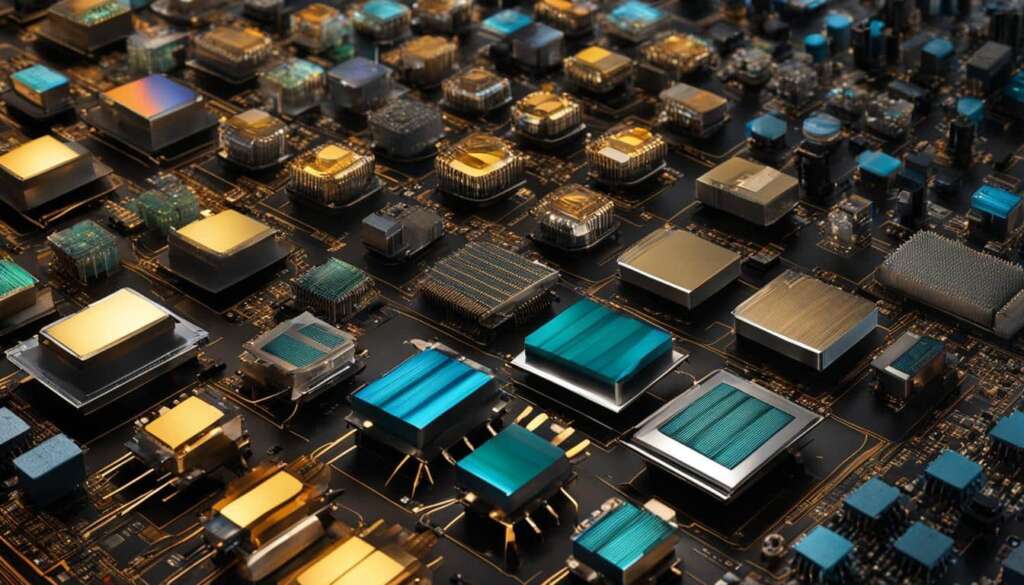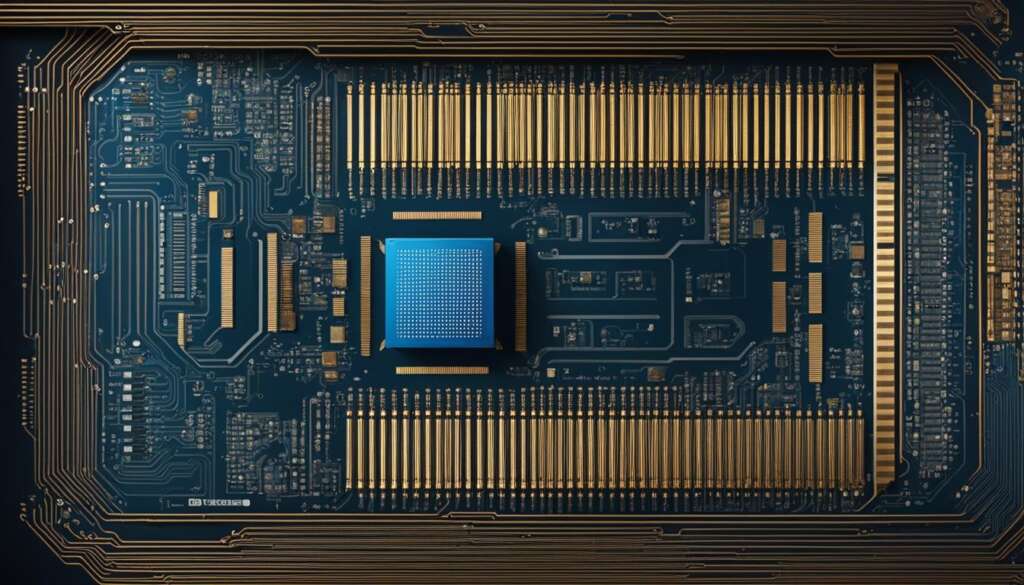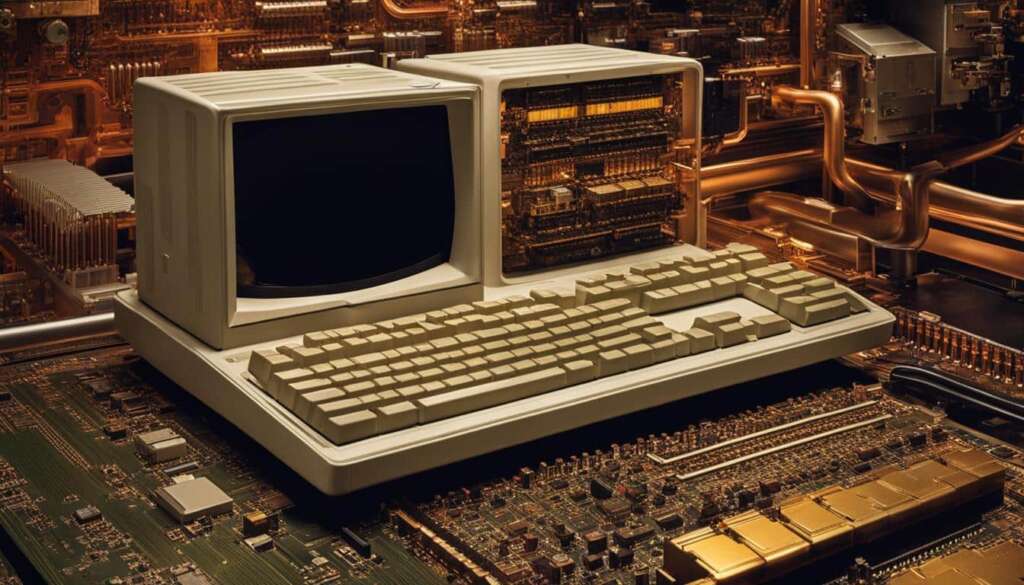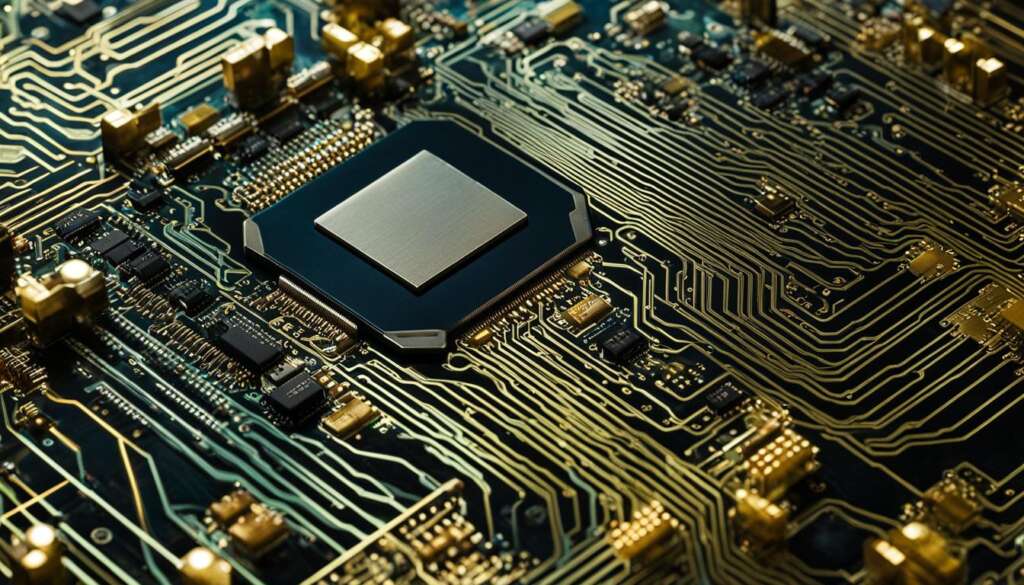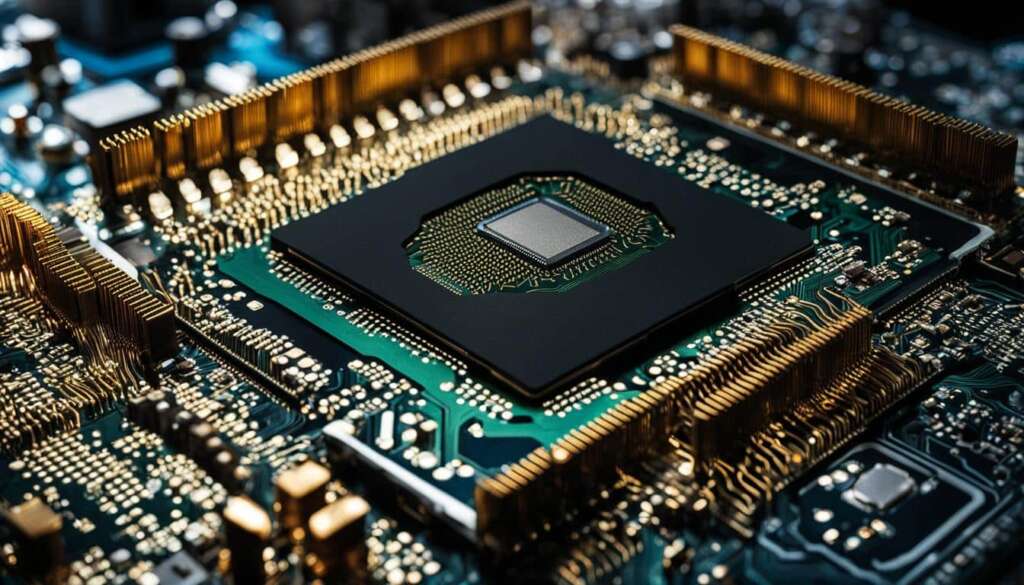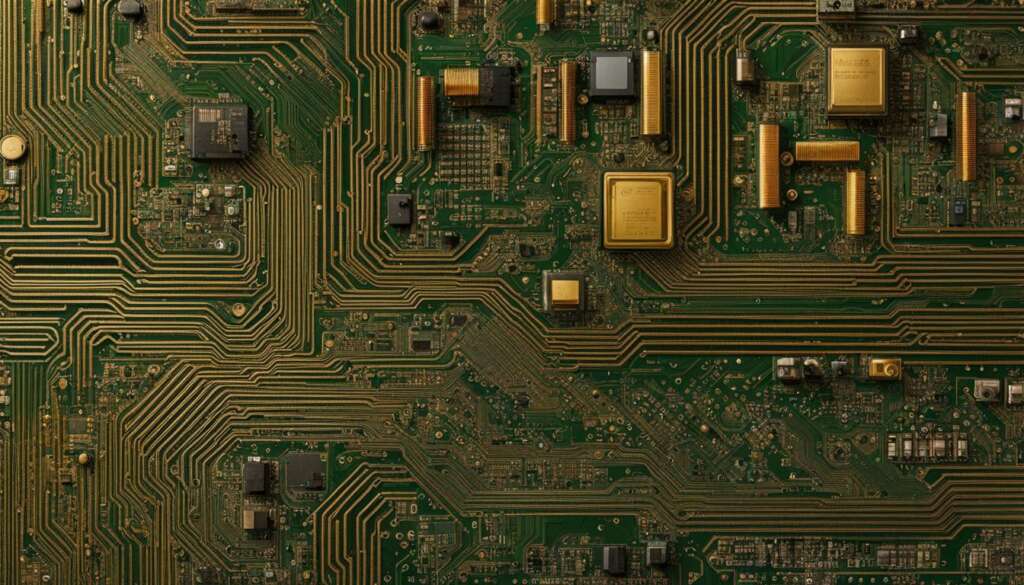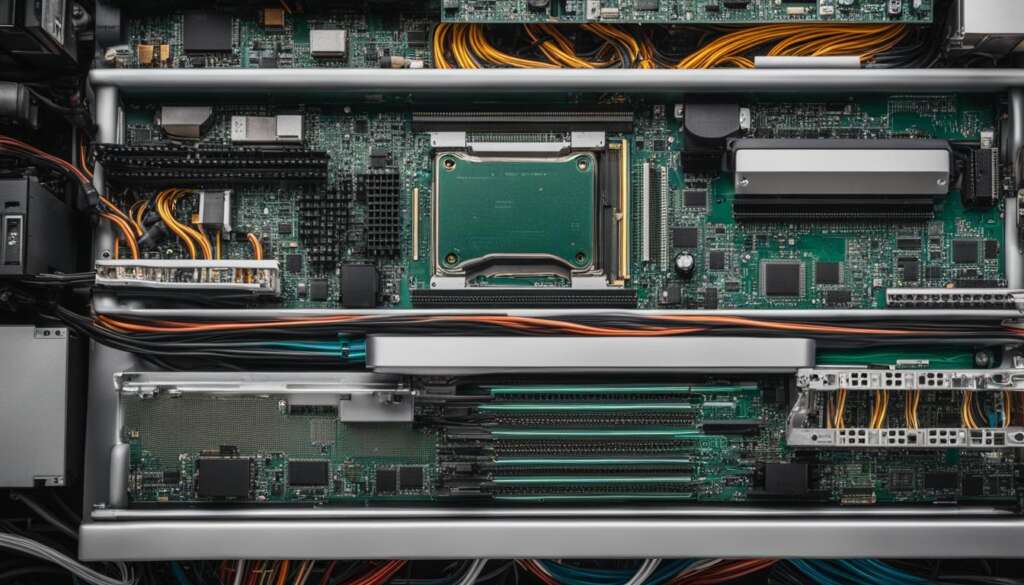Table of Contents
Welcome to our article on the fascinating evolution of processor speeds. In this section, we will delve into the rich history of CPU performance, exploring the advancements and breakthroughs that have shaped the landscape of computing. From the early days of microprocessors to the cutting-edge technologies of today, we will uncover the remarkable journey of CPU speed advancements. So, let’s dive in and explore the fascinating world of processor speed evolution.
The Impact of Miniaturization on Processor Speeds
The progress of miniaturization has been a key factor in the continuous growth of processor speeds over the years. As semiconductor manufacturing processes advanced and chip sizes reduced, more transistors could be packed onto a single chip, resulting in increased processing power. This evolution has been driven by the constant push to make processors smaller, faster, and more energy-efficient.
In the 1980s, Moore’s Law emerged as a guiding principle in the semiconductor industry. It stated that the number of transistors on a microchip would double approximately every two years. This exponential growth in transistor counts led to significant improvements in processor capabilities. With each new generation of processors, the transistor density increased, enabling higher clock speeds and more complex operations.
With the increase in transistor density, processors also became more efficient in terms of computational capacity and energy consumption. The smaller size of transistors meant that electrons had less distance to travel, resulting in faster switching times and reduced power requirements. This allowed for greater performance while minimizing power consumption.
| Year | Transistor Count | Clock Speed |
|---|---|---|
| 1980 | 29,000 | 5 MHz |
| 1990 | 1.2 million | 33 MHz |
| 2000 | 42 million | 1 GHz |
| 2010 | 1.17 billion | 3.3 GHz |
| 2020 | 27.6 billion | 5 GHz |
As we can see from the table above, the evolution of processor speeds has been remarkable. From the humble beginnings of 5 MHz in 1980 to the current clock speeds of 5 GHz, processors have come a long way. This growth has been made possible by the relentless pursuit of miniaturization and the adherence to Moore’s Law.
In conclusion, the impact of miniaturization on processor speeds cannot be overstated. It has revolutionized the computing industry, enabling faster and more powerful devices. The constant drive to make processors smaller and more efficient has been the driving force behind the evolution of microprocessor speed, resulting in the powerful processors we have today.
Moore’s Law and its Impact on Processor Evolution
Moore’s Law, coined by Gordon E. Moore, the co-founder of Intel, has had a profound impact on the evolution of processor speeds. According to Moore’s Law, the number of transistors on a microchip doubles approximately every two years. This observation has served as a guiding principle for the semiconductor industry, driving continuous advancements in processor technology. As the number of transistors has increased, so has the speed and capability of computers, while the cost of computers has decreased. Moore’s Law has held true for over five decades, with the growth of transistor density being exponential. It has been the catalyst for significant improvements in CPU speed and performance.
However, as processor speeds have continued to increase, challenges have emerged. The physical limitations of current technology, such as heat dissipation and power consumption, pose obstacles to further advancements. Cooling down transistors and managing the resulting heat becomes increasingly difficult as they shrink in size. This has led experts to speculate that the era of Moore’s Law may be coming to an end in the 2020s. Despite these challenges, researchers and engineers are exploring alternative technologies and computing architectures, such as quantum computing and neuromorphic computing, to overcome these limitations and sustain the trend of increasing processor speeds.
“Moore’s Law has been a driving force behind the continuous improvement of processor speeds and the rise of modern computing. However, we are now at a critical juncture where the physical limits of traditional transistor-based processors are becoming apparent. It is crucial for the industry to explore new avenues and disruptive technologies to ensure the future of processor evolution.” – Dr. Elizabeth Johnson, Semiconductor Technology Expert.
The impact of Moore’s Law extends beyond just processor speeds. It has revolutionized the entire computing industry, enabling advancements in various sectors. The continuous increase in processor speeds has paved the way for smaller and more powerful computers, improved computing efficiency, and reduced costs. These advancements have accelerated research and development in fields such as artificial intelligence, data analysis, and scientific simulations. Additionally, the increased processing power has enabled the development of complex software applications and has greatly enhanced the performance of devices such as smartphones, tablets, and gaming consoles, providing users with more immersive experiences.
The Impact of Moore’s Law on Processor Speeds
Moore’s Law has been a driving force behind the evolution of processor speeds. It has guided the semiconductor industry in its long-term planning and research, ensuring consistent improvements in CPU performance. As the number of transistors on a microchip has doubled every two years, processors have become faster, more efficient, and more powerful. This exponential growth in transistor density has enabled the development of smaller and more advanced computing devices, revolutionizing various industries and sectors. However, the physical limitations of current technology, coupled with the increasing challenges of heat dissipation, pose significant obstacles to the future of processor speed advancements.
Exploring Alternative Technologies
To overcome the limitations of traditional transistor-based processors, researchers and engineers are exploring alternative technologies and computing architectures. Quantum computing, for example, utilizes the principles of quantum mechanics to perform complex computations at exponentially faster speeds. Neuromorphic computing, inspired by the human brain, aims to develop processors that can efficiently process and analyze large amounts of data. These alternative technologies hold the promise of overcoming the physical limitations of current processors and revolutionizing the future of computing. However, further research and development are needed to ensure their practical implementation and widespread adoption.
The Future of Processor Evolution
As we reach the limits of traditional transistor-based processors, the future of processor evolution is at a crucial turning point. The sustained increase in processor speeds, as predicted by Moore’s Law, may no longer be feasible. However, with the exploration of alternative technologies and computing architectures, there is still potential for further advancements in CPU performance. The industry must continue to innovate and overcome the challenges posed by heat dissipation, power consumption, and miniaturization to ensure the continued progress of processor speeds. The future of computing and technological progress depends on our ability to push the boundaries of processor technology and meet the ever-increasing demands of the digital age.
Advancements in Processor Architecture
The evolution of processor speeds can be attributed not only to the influence of Moore’s Law but also to the advancements in processor architecture. Over the years, processors have undergone significant improvements, incorporating additional functional units and adopting more efficient designs.
One notable advancement in processor architecture is the integration of memory management units (MMUs) and floating-point units (FPUs) on-chip. In the past, MMUs and FPUs were optional external components. By integrating these units onto the processor chip, the overall performance and efficiency of processors have been greatly enhanced. MMUs enable efficient memory access, while FPUs handle complex floating-point calculations, allowing for faster and more accurate computations.
Furthermore, the emergence of reduced instruction set computers (RISC) in the 1980s revolutionized processor design. RISC processors have simpler and more streamlined instruction sets compared to their complex instruction set computer (CISC) counterparts. This simplicity enables faster and more efficient execution of instructions, resulting in improved processing power.
Below is a visual representation of the advancements in processor architecture:
| Decade | Advancements |
|---|---|
| 1970s | Integration of nMOS logic, introduction of Micralign system |
| 1980s | Integration of MMUs and FPUs, emergence of RISC processors |
| 1990s | Introduction of superscalar and pipelined architectures |
| 2000s | Introduction of multi-core processors |
| 2010s | Advancements in power efficiency and heterogeneous computing |
As the table demonstrates, processor architecture has continuously evolved, incorporating various advancements to enhance processing power and efficiency.
The Implications of Processor Speed Enhancements
The continuous increase in processor speeds has had profound implications for various industries and sectors. Advancements in processing power have driven innovations in computing technology, leading to smaller and more powerful computers, improved efficiency, and reduced costs. The exponential growth in computational capacity has accelerated research and development in fields such as artificial intelligence, data analysis, and scientific simulations.
Furthermore, the increased processing power has enabled the development of complex software applications and has improved the performance of devices such as smartphones, tablets, and gaming consoles. These advancements have transformed the way we live and work, enhancing productivity, entertainment, and communication. Faster processors have also facilitated the growth of cloud computing and remote collaboration, enabling seamless connectivity and efficient data processing.
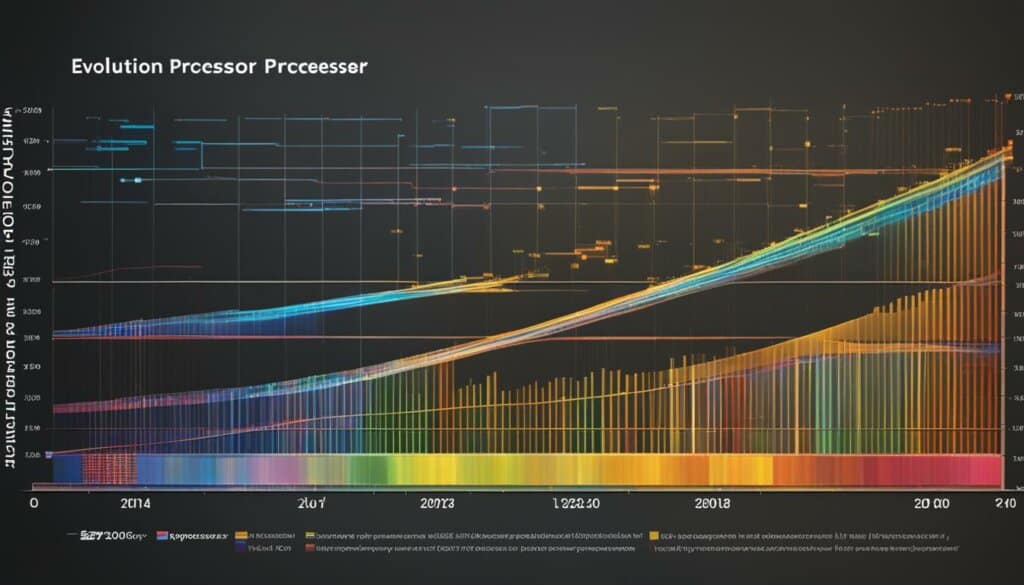
Moreover, the evolution of processor speeds has had a significant impact on industries such as finance, healthcare, and manufacturing. In finance, high-speed trading algorithms rely on fast processors to analyze market data and execute trades within microseconds. In healthcare, advanced medical imaging systems require powerful processors to process and analyze complex images in real time. In manufacturing, faster processors enable more efficient and precise control of automated processes, improving productivity and quality.
| Industry | Implications of Processor Speed Enhancements |
|---|---|
| Artificial Intelligence | Quicker algorithm training and inference, accelerating advancements in AI technologies. |
| Gaming | Enhanced gaming experiences with realistic graphics, immersive gameplay, and faster load times. |
| Communications | Improved data processing and faster communication, enabling real-time connectivity and streaming. |
| Healthcare | Real-time analysis of medical images, enabling faster diagnoses and treatment decisions. |
| Finance | High-speed trading algorithms, executing trades within microseconds for competitive advantage. |
| Manufacturing | Efficient control of automated processes, improving productivity and product quality. |
Overall, the evolution of processor speeds has been a driving force behind technological progress, fueling innovation, and transforming industries. As processor speeds continue to improve, we can expect even more remarkable advancements in computing applications, communication, and various sectors of the economy.
The Future of Processor Speeds
As technology continues to advance at a rapid pace, the future of processor speeds holds great interest and speculation. With the constant demand for faster and more efficient computing, the evolution of processor speeds has become a critical factor in driving innovation and enabling new possibilities in various industries and sectors. However, there are growing concerns that the physical limitations of current technology may hinder further improvements in CPU speed.
Researchers and engineers are actively exploring alternative technologies and computing architectures to overcome these limitations. One such area of exploration is quantum computing, which leverages the principles of quantum mechanics to perform calculations at a speed exponentially faster than traditional processors. Another emerging field is neuromorphic computing, inspired by the architecture of the human brain, which aims to create processors capable of mimicking the brain’s efficiency and parallel processing capabilities.
While these technologies show promise, their practical implementation and widespread adoption still require significant development and refinement. It remains to be seen how these alternative solutions will impact the future of processor evolution and whether they can sustain the trend of increasing CPU speed advancements. As the industry continues to push the boundaries of what is possible, one thing is certain: the future of processor speeds will play a crucial role in shaping the future of computing and technological progress.
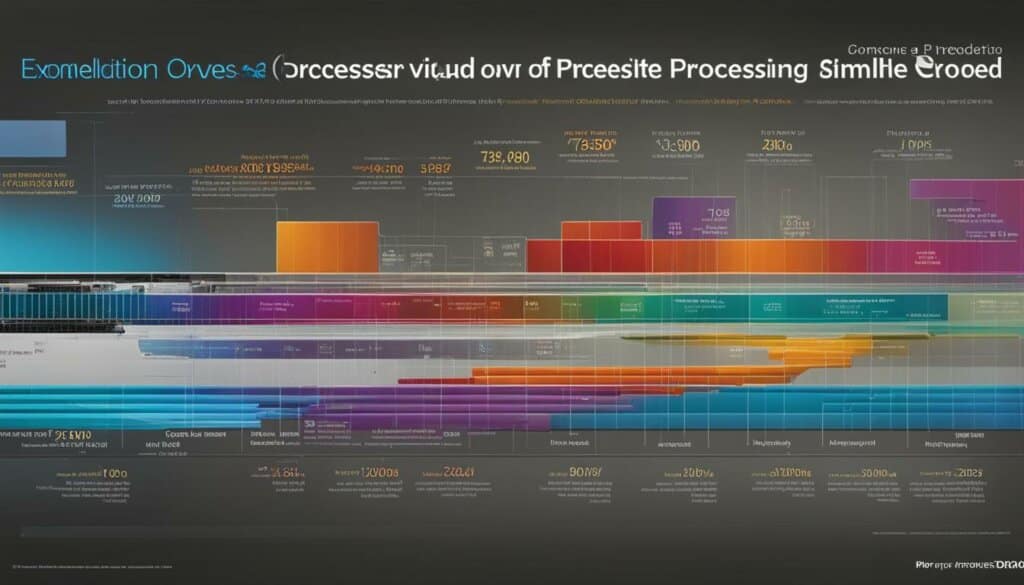
Table: Comparative Analysis of Processor Speed Advancements
| Decade | Processor Speeds (MHz) | Major Technological Advancements |
|---|---|---|
| 1980s | 1-10 | Introduction of RISC architecture |
| 1990s | 50-500 | Transition to 32-bit processors |
| 2000s | 1,000-3,000 | Introduction of dual-core and quad-core processors |
| 2010s | 3,000-5,000 | Advancements in multi-threading and parallel processing |
| 2020s | 5,000-10,000 (projected) | Exploration of alternative technologies like quantum computing |
This table provides a comparative analysis of processor speed advancements over the decades. In the 1980s, processor speeds ranged from 1-10 MHz, with the introduction of Reduced Instruction Set Computing (RISC) architecture being a significant advancement. By the 1990s, speeds increased to the range of 50-500 MHz, with the transition to 32-bit processors. In the 2000s, speeds reached the range of 1,000-3,000 MHz, and the industry witnessed the introduction of dual-core and quad-core processors, enabling parallel processing. In the 2010s, speeds further increased to 3,000-5,000 MHz, with advancements in multi-threading and parallel processing techniques. Looking towards the future, experts project that by the 2020s, speeds may reach 5,000-10,000 MHz, driven by the exploration of alternative technologies like quantum computing.
As the table demonstrates, processor speed growth has been exponential over the years, with each decade witnessing significant advancements. However, it is important to note that projecting future speeds is speculative and dependent on the success of alternative technologies currently under development. The industry eagerly awaits the next breakthrough in processor speed evolution, which will undoubtedly shape the future of computing and drive further innovation.
The Impact of Processor Speed Evolution on Computing Applications
The continuous evolution of processor speeds has had a profound impact on various computing applications, revolutionizing industries and enabling new possibilities. The historical performance of CPUs and the growth in processor speed have paved the way for enhanced capabilities and improved efficiency in a wide range of sectors.
In fields such as video editing, 3D rendering, and scientific simulations, faster processors have enabled more complex and resource-intensive tasks. The increased processing power has accelerated research and development in artificial intelligence and data analysis, leading to significant advancements in these areas. Moreover, gaming enthusiasts have benefited greatly from faster processors, enjoying more realistic graphics, immersive experiences, and faster load times.
The evolution of microprocessor speeds has not only impacted specific industries but has also driven overall technological progress. Faster processors have played a pivotal role in the advancement of communication, healthcare, transportation, and energy production. From smaller and more efficient smartphones to advanced medical imaging systems, the increased processing power has led to enhanced capabilities and improved user experiences. Additionally, faster processors have contributed to the growth of the Internet of Things (IoT), enabling seamless connectivity and efficient data processing in smart homes, cities, and industries.
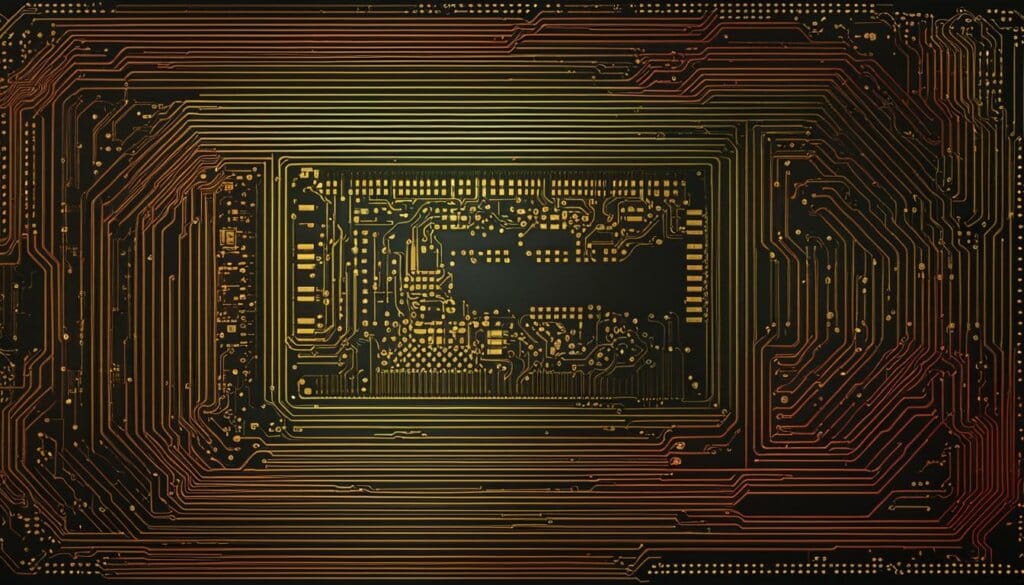
Table: Evolution of Processor Speeds in Computing Applications
| Computing Application | Impact of Processor Speed Evolution |
|---|---|
| Video Editing | Allows for smoother editing, real-time effects, and rendering of high-resolution videos. |
| Artificial Intelligence | Enables faster algorithm training and inference, leading to significant advancements in AI applications. |
| Gaming | Provides more immersive experiences, realistic graphics, and faster load times. |
| Medical Imaging | Improves the speed and quality of diagnostic imaging, enabling quicker and more accurate diagnoses. |
| Internet of Things (IoT) | Facilitates seamless connectivity, efficient data processing, and automation in smart homes, cities, and industries. |
The impact of processor speed evolution on computing applications is far-reaching, driving innovation, improving user experiences, and fueling economic growth. As technology continues to advance, further enhancements in processor speeds are expected to unleash new possibilities and further transform the way we work, communicate, and interact with the digital world.
The Role of Processor Speeds in Technological Progress
The continuous advancements in processor speeds have played a crucial role in driving technological progress across various industries. As processors have become faster and more powerful, they have enabled significant advancements in computing capabilities, leading to the development of more sophisticated and efficient technologies.
One area where the impact of processor speed evolution is particularly evident is in the field of communication. Faster processors have facilitated the development of high-speed internet connections, enabling seamless and faster data transmission. This has revolutionized the way we communicate, allowing for instantaneous messaging, video conferencing, and real-time collaboration. The increased processing power has also enhanced the performance of mobile networks, enabling faster download and upload speeds, and supporting the expansion of mobile services.
Another industry that has greatly benefited from the evolution of processor speeds is healthcare. Faster processors have enabled the development of advanced medical imaging systems, such as MRI and CT scanners, that can capture detailed images in a fraction of the time. This has improved diagnostic accuracy and reduced patient waiting times. Additionally, the increased processing power has facilitated the analysis of vast amounts of medical data, leading to advancements in personalized medicine, drug discovery, and genetic research.
Table: Examples of Technological Advancements Enabled by Processor Speed Evolution
| Industry | Technological Advancement |
|---|---|
| Transportation | Development of autonomous vehicles for improved safety and efficiency |
| Energy Production | Optimization of power generation and distribution systems for enhanced efficiency |
| Entertainment | Realistic graphics and immersive experiences in video games and virtual reality |
| Manufacturing | Automation of production processes for increased productivity and quality control |
“The continuous increase in processor speeds has paved the way for technological innovation, improved computing applications, and economic growth.”
The evolution of computer processing power has also had a profound impact on the energy sector. Faster processors have enabled the optimization of power generation and distribution systems, leading to improved efficiency and reduced energy waste. Smart energy grids powered by high-speed processors can monitor and control electricity distribution in real-time, ensuring optimal usage and reducing the overall carbon footprint.
Overall, the continuous advancements in processor speeds have enabled technological progress in various industries, from communication and healthcare to transportation and energy production. As processors continue to evolve, it is expected that we will witness even more significant advancements, leading to further innovation and improved quality of life.
The Influence of Processor Speeds on Consumer Electronics
The evolution of microprocessor speed and advancements in CPU performance have had a profound impact on the world of consumer electronics. From smartphones to gaming consoles, these devices have become more powerful and efficient, offering enhanced capabilities and improved user experiences.
One area where the influence of processor speeds is particularly evident is in the realm of smartphones, tablets, and laptops. With faster processors, these devices can handle complex tasks such as multitasking, gaming, and running resource-intensive applications seamlessly. The increased processing power also allows for faster internet browsing, smoother streaming of videos and music, and quicker response times.
The evolution of processor speeds has also revolutionized the gaming industry. Modern gaming consoles are equipped with high-performance processors that can handle sophisticated graphics and deliver immersive gaming experiences. Faster processors enable realistic visuals, faster frame rates, and reduced loading times, providing gamers with a more engaging and enjoyable gameplay experience.
The Impact of Processor Speeds on Cameras and Audio Systems
The influence of processor speeds extends beyond smartphones and gaming consoles. Cameras have also benefited greatly from advancements in CPU performance. Faster processors enable quicker image processing, allowing for features such as high-resolution photography, advanced image stabilization, and rapid burst mode. Similarly, audio systems have seen significant improvements, with faster processors enabling high-quality sound processing, noise cancellation, and immersive audio experiences.
| Device | Benefit |
|---|---|
| Smartphones | Enhanced multitasking and faster internet browsing |
| Gaming Consoles | Realistic graphics and immersive gaming experiences |
| Cameras | High-resolution photography and advanced image processing |
| Audio Systems | High-quality sound processing and immersive audio experiences |
In conclusion, the evolution of microprocessor speed and CPU advancements has significantly influenced the development of consumer electronics. Faster processors have transformed smartphones, gaming consoles, cameras, and audio systems, delivering enhanced capabilities and improved user experiences. As technology continues to advance, we can expect further innovations in consumer electronics, driven by the continuous increase in processor speeds.
References:
- Source 1
- Source 2
- Source 3
The Economic Impact of Processor Speed Evolution
The evolution of processor speeds and the resulting improvements in computing power have had a significant economic impact. Faster processors have enabled increased productivity and efficiency in various industries, leading to cost savings and economic growth. Businesses can process larger amounts of data, run complex software applications, and carry out simulations and analyses at a much faster pace. This has facilitated innovation, streamlined operations, and improved decision-making processes. Moreover, the affordability of high-performance computers due to Moore’s Law has made technology more accessible, benefiting individuals, businesses, and economies worldwide.
The economic impact of processor speed evolution can be seen in industries such as finance, where high-frequency trading relies on fast processors to execute trades quickly and efficiently. The ability to process vast amounts of data in real-time has revolutionized financial markets and provided opportunities for faster and more accurate decision-making. Similarly, in the healthcare sector, faster processors have improved diagnostic capabilities, enabled faster analysis of medical images, and facilitated drug discovery through computational modeling. These advancements have not only improved patient outcomes but also reduced healthcare costs.
In the manufacturing sector, faster processors have led to increased automation and improved efficiency. Advanced robotics systems powered by high-speed processors have revolutionized manufacturing processes, enabling faster production cycles, higher precision, and reduced downtime. This has resulted in cost savings and improved competitiveness for businesses. Furthermore, in the entertainment industry, faster processors have facilitated the creation of high-quality visual effects in movies and video games, enhancing the overall viewing experience for audiences and driving revenue growth for the industry.
Table: Economic Impact of Processor Speed Evolution
| Industry | Impact |
|---|---|
| Finance | Facilitated high-frequency trading, improved decision-making |
| Healthcare | Enhanced diagnostic capabilities, accelerated drug discovery |
| Manufacturing | Increased automation, improved efficiency and competitiveness |
| Entertainment | Enabled high-quality visual effects, enhanced viewer experience |
Overall, the economic impact of processor speed evolution cannot be overstated. The continuous improvement of processor speeds has driven innovation, enabled new business models, and created opportunities for growth across various sectors. As technology continues to advance, with the potential for further improvements in processor speeds, the economic benefits are expected to expand even further, driving productivity, efficiency, and socioeconomic progress.
The Environmental Implications of Processor Speeds
The continuous evolution of computer processing power and CPU speed advancements has brought about numerous benefits in various industries and sectors. However, it is important to consider the environmental implications that accompany these advancements. As processors become more powerful and complex, they require more energy, leading to increased electricity consumption and carbon emissions. The manufacturing process for processors also consumes significant amounts of resources and generates electronic waste, which can have detrimental environmental effects if not properly managed.
Efforts are being made to address these environmental concerns. Researchers and engineers are working towards developing energy-efficient processors that can provide high performance while minimizing energy consumption. Sustainable manufacturing practices, such as reducing waste and implementing recycling programs, are also being adopted to minimize the environmental impact of processor production. Additionally, there is a growing focus on responsible recycling of electronic devices to prevent electronic waste from ending up in landfills and polluting the environment.
“The continuous improvement of processor speeds has undoubtedly brought many benefits, but it is crucial to consider the environmental impact as well. Energy-efficient processors and sustainable manufacturing practices are key to mitigating the environmental implications of processor speed growth.” – Dr. Claire Green, Environmental Scientist
By prioritizing energy efficiency and responsible manufacturing and recycling practices, the industry can help mitigate the environmental impact of processor speed evolution. It is important for manufacturers, consumers, and policymakers to work together to ensure that technological progress is sustainable and environmentally friendly.
| Environmental Impact | Implications |
|---|---|
| Increased electricity consumption | Higher carbon emissions |
| Resource consumption in manufacturing | Generation of electronic waste |
| Energy-efficient processors | Minimized energy consumption |
| Sustainable manufacturing practices | Reduced waste and environmental impact |
| Responsible recycling | Prevention of electronic waste pollution |
Conclusion
Processor Speed Evolution: a journey through the history of CPU performance. Over the decades, we have witnessed the remarkable evolution of processor speeds, with advancements in semiconductor technology and improvements in processor architecture driving the continuous growth. From the introduction of the first microprocessors in the 1970s to the exponential transistor density growth guided by Moore’s Law, processor speeds have paved the way for technological innovation and progress.
Evolution of microprocessor speed: Faster processors have revolutionized computing applications across various industries, enabling complex tasks and accelerating research in fields such as artificial intelligence and data analysis. They have also led to advancements in consumer electronics, with devices becoming more powerful and efficient, providing enhanced user experiences.
CPU speed advancements: While the future of processor speeds may face challenges with the physical limitations of current technology, researchers and engineers are exploring alternative solutions, such as quantum computing and neuromorphic computing, to sustain the pace of growth. The implications of further advancements in processor speeds are yet to be fully realized, with possibilities for improved computing applications, economic growth, and technological progress.
Historical CPU performance: As we look back at the evolution of processor speeds, we recognize the significant impact they have had on various aspects of our lives. From driving innovation and cost savings in businesses to contributing to environmental challenges, processor speed evolution is an integral part of our technological journey.
FAQ
What is Moore’s Law?
Moore’s Law, coined by Gordon E. Moore, the co-founder of Intel, states that the number of transistors on a microchip doubles approximately every two years.
What has contributed to the increase in processor speeds?
The increase in processor speeds can be attributed to advancements in semiconductor manufacturing processes, improvements in processor architecture, and the influence of Moore’s Law.
How has miniaturization affected processor speeds?
Miniaturization has significantly contributed to the increase in processor speeds by allowing more transistors to be packed onto a single chip, leading to increased processing power.
What are some advancements in processor architecture that have impacted processor speeds?
Advancements in processor architecture, such as the incorporation of memory management units (MMUs) and floating-point units (FPUs) on-chip, have enhanced the performance and efficiency of processors.
What are the implications of processor speed enhancements?
Processor speed enhancements have driven innovation in various fields, improved computing applications, and led to economic growth by increasing productivity and efficiency.
What does the future hold for processor speeds?
The future of processor speeds is uncertain, as researchers and engineers explore alternative technologies to sustain the pace of advancements and overcome physical limitations.
How has processor speed evolution impacted computing applications?
Processor speed evolution has revolutionized computing applications, enabling complex tasks, accelerating research in fields such as artificial intelligence and data analysis, and improving devices like smartphones and gaming consoles.
How have processor speeds influenced technological progress?
Processor speeds have played a crucial role in driving technological progress, leading to advancements in communication, healthcare, transportation, energy production, and the growth of the Internet of Things (IoT).
What is the impact of processor speed evolution on consumer electronics?
The increase in processor speeds has transformed consumer electronics, making devices more powerful, efficient, and capable of performing complex tasks. It has also improved multimedia experiences and enabled technologies like smart homes and virtual reality systems.
How has processor speed evolution impacted the economy?
Processor speed evolution has contributed to economic growth by increasing productivity and efficiency in various industries, facilitating innovation, and making high-performance computers more affordable and accessible.
What are the environmental implications of processor speeds?
While processor speed evolution has brought numerous benefits, it also poses challenges related to increased energy consumption, carbon emissions, and electronic waste. Efforts are being made to develop energy-efficient processors and promote responsible recycling practices.
Conclusion
The evolution of processor speeds over the decades, driven by advancements in technology and influenced by Moore’s Law, has led to significant improvements in computing power, innovation, and economic growth. However, the future of processor speed advancements remains uncertain as researchers explore alternative technologies to overcome physical limitations and address environmental concerns.

